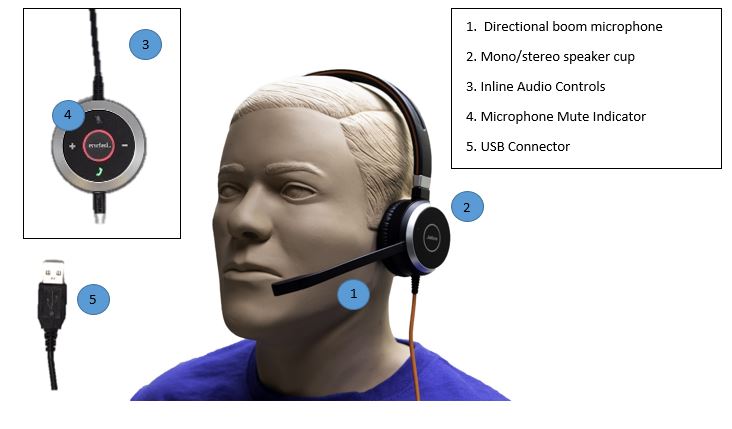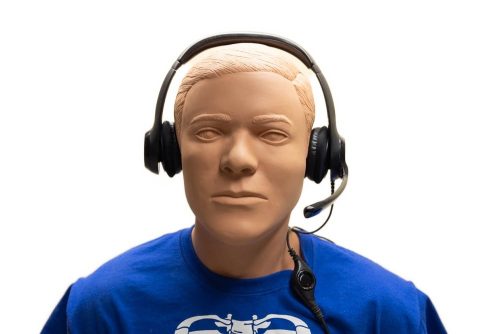For one-to-one conversations, a wired USB Headset is one of the most straightforward upgrades for most Telehealth applications. The key benefit of a headset is that the audio source is closer to a user’s mouth and creates a more present audio experience for the listener.
Other Potential benefits provided by a USB Headset may include:
- Improved Audio Quality
- Simple and Reliable Setup and Connection
- Broad Platform Compatibility
- User Comfort Over Long Wear Times
- Ease of Use
- Greater Privacy and Security Control
Generally affordable, these sorts of devices often provide the most cost-effective means for improving the provider-side audio experience in Telehealth applications. This has benefits for both the provider and the patient.
About this Technology
There are two main categories of headsets on the market, wireless headsets that use Bluetooth or wireless connectivity, and wired headsets that generally connect using standard USB plug-and-play technology. This article will explore a range of USB-Wired headsets as we have found the simplicity of their form and function often make them essential components of a program’s telehealth experience. Why should we focus on audio solutions? Most users who remember trying to work remotely during the pandemic will recall how frustrating the lack of audio clarity was in those early days due to the strain on meeting platforms and the inferiority of built-in laptop speakers and microphones. Low-cost and easy-to-use peripherals have and continue to mitigate some of those experienced issues.
The devices informing this article are the Microsoft LifeChat LX-6000, Jabra Evolve2 40 (non-SE), and the Logitech H390 USB Headset. All of these devices have an MSRP of under $150. All of these devices include a standard USB-A connection, inline controls (mute, volume up/down, etc.), and a form of noise cancelation on the part of the microphone. These devices use plug-and-play USB driver technology and are cross-platform compatible with Windows, MacOS, and ChromeOS.
Innovative Features and Components
- Directional boom microphone with Active Noise Cancellation (ANC): These USB headsets incorporate a form of active noise cancellation technology. ANC uses built-in microphones to analyze ambient noise and generate inverse sound waves to cancel out background noise. This feature is particularly beneficial in noisy environments, allowing users to focus on their conversations without distraction. This can be particularly effective when paired with the narrow focus of the headset microphone that sits just in front of the speaker’s mouth.
- Mono or stereo speaker cups: Our example technologies all include stereo speaker cups, though many manufacturers also offer single-ear models. These cups are generally padded to provide additional comfort over long periods of use.
- Inline Audio Controls: These USB headsets have inline controls conveniently placed on the cable. These controls allow users to adjust volume levels, mute/unmute the microphone, answer or end calls, and sometimes even control media playback. Having these controls readily accessible on the headset cable enables easy and quick adjustments without the need to interact with the connected device.
- Microphone Mute Indicator: These USB headsets feature an LED indicator on the inline controls to signal whether the microphone is muted or active. This visual cue helps users quickly determine their microphone status at a glance, preventing unintentional or unnoticed muted conversations. These sorts of easy-to-read indicators can help when troubleshooting audio connections.
- USB Connector: A majority of devices support the larger USB-A connection, though we are seeing a rise in the number of devices beginning to support USB-C connectors. Adaptors that convert from USB-A to USB-C, or from USB-C to USB-A are readily available.

Supported Use Cases
- Audio Communication: USB-wired headsets are primarily used for clear and effective audio communication between healthcare professionals and patients. They enable healthcare providers to hear patients’ voices accurately and provide clear instructions or guidance. Similarly, patients can communicate their symptoms or concerns clearly, ensuring effective remote consultations.
- Teleconferencing and Team Collaboration: USB-wired headsets are valuable for teleconferencing and team collaboration, especially in telehealth settings involving multidisciplinary teams or group discussions. Healthcare professionals can participate in remote meetings, discuss patient cases, and share insights or recommendations with colleagues using clear and reliable audio communication.
- Patient Education and Counseling: USB-wired headsets play a vital role in patient education and counseling during telehealth sessions. Healthcare providers can use them to explain medical conditions, treatment options, or preventive measures clearly and engagingly. Patients can listen attentively, ask questions, and fully understand the information.
- Language Interpretation: Telehealth often serves diverse populations, including individuals who may require language interpretation services. USB-wired headsets can facilitate language interpretation during remote consultations. An interpreter can join the telehealth session via a separate audio channel, providing real-time interpretation for patients and healthcare providers.
- Remote Monitoring and Assessments: In telehealth scenarios where remote monitoring or assessments are conducted, USB-wired headsets can support accurate audio transmission. For instance, a provider can use the headset to listen to a digital stethoscope recording during virtual physical exams.
- Documenting Medical Notes: When paired with dictation software, USB-wired headsets can assist healthcare professionals in documenting medical notes accurately during telehealth encounters. By wearing the headset, providers can directly speak their observations, recommendations, and orders into the microphone, allowing for efficient and hands-free documentation.
- Mental Health Support: USB-wired headsets can be particularly helpful for tele-mental health use cases. They can allow therapists or counselors to have confidential and clear conversations with patients, facilitating effective therapy sessions. Patients can openly express their thoughts and emotions while receiving guidance from a mental health professional.
- Training and Continuing Education: In telehealth environments that involve training sessions or continuing education for healthcare professionals, USB-wired headsets are valuable tools. They enable trainers or instructors to deliver presentations, conduct demonstrations, or provide audio-based training materials while ensuring clear and uninterrupted communication.
These use cases demonstrate the wide range of versatility USB-wired headsets can provide in telehealth, supporting effective communication, collaboration, education, and patient care. The audio clarity, reliability, and compatibility of these headsets can help to contribute to a telehealth experience that is as technologically seamless for both healthcare providers and patients as possible.
From time to time, TAC will choose a piece of technology to show or demonstrate in our website’s “Innovation Watch” section. No endorsement of any products or services is expressed or implied by any information, hyperlink text, product, service, material, or content referred to or included on, or linked from, or to the TTAC website.
From time to time TAC will choose a piece of technology to show or demonstrate in the “Innovation Watch” section of our website. No endorsement of any products or services is expressed or implied by any information, hyperlink text, product, service, material or content referred to or included on, or linked from or to the TTAC web site.

